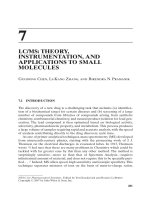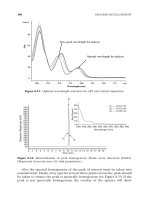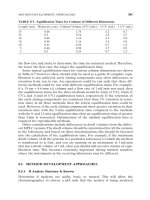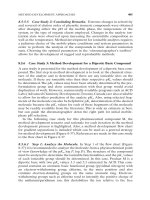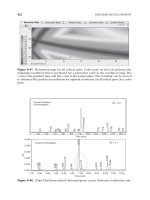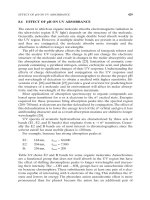Tài liệu Methods for Disaster Mental Health Research pdf
Bạn đang xem bản rút gọn của tài liệu. Xem và tải ngay bản đầy đủ của tài liệu tại đây (1.31 MB, 352 trang )
METHODS FOR DISASTER
MENTAL HEALTH RESEARCH
Methods for Disaster
Mental Health Research
Edited by
FRAN H. NORRIS
SANDRO GALEA
MATTHEW J. FRIEDMAN
PATRICIA J. WATSON
THE GUILFORD PRESS
New York London
© 2006 The Guilford Press
A Division of Guilford Publications, Inc.
72 Spring Street, New York, NY 10012
www.guilford.com
All rights reserved
No part of this book may be reproduced, translated, stored in
a retrieval system, or transmitted, in any form or by any means,
electronic, mechanical, photocopying, microfilming, recording,
or otherwise, without written permission from the Publisher.
Printed in the United States of America
This book is printed on acid-free paper.
Last digit is print number: 987654321
Library of Congress Cataloging-in-Publication Data
Methods for disaster mental health research / edited by Fran H. Norris . . . [et al.].
p. ; cm.
Includes bibliographical references and index.
ISBN-10: 1-59385-310-6 ISBN-13: 978-1-59385-310-5 (cloth : alk. paper)
1. Post-traumatic stress disorder. 2. Disasters—Psychological aspects. I. Norris, Fran H.
[DNLM: 1. Disasters. 2. Stress Disorders, Post-Traumatic. 3. Research—methods.
WM 170 M592 2006]
RC552.P67M48 2006
616.85′21—dc22
About the EditorsAbout the Editors
About the Editors
Fran H. Norris, PhD, a community/social psychologist, is a Research Pro-
fessor in the Department of Psychiatry at Dartmouth Medical School,
where she is affiliated with the National Center for PTSD and the National
Consortium for the Study of Terrorism and Responses to Terrorism
(START) headed by the University of Maryland. Dr. Norris has received
numerous grants for research, research education, and professional devel-
opment and has published extensively on the psychosocial consequences of
disasters. She is the Deputy/Statistical Editor for the Journal of Traumatic
Stress and received the 2005 Robert S. Laufer Award for Outstanding
Scientific Achievement from the International Society for Traumatic Stress
Studies.
Sandro Galea, MD, DrPH, is an Associate Professor of Epidemiology at the
University of Michigan School of Public Health and a Research Affiliate of
the Population Studies Center at the Institute for Social Research. His research
focuses on the social and economic production of health, particularly men
-
tal health and behavior in urban settings, and he has an abiding interest in
the social and health consequences of collectively experienced traumatic
events. Dr. Galea completed his graduate training at the University of
Toronto Medical School, at the Harvard University School of Public
Health, and at the Columbia University Mailman School of Public Health.
Matthew J. Friedman, MD, PhD, is Executive Director of the U.S. Depart
-
ment of Veterans Affairs National Center for PTSD and Professor of Psy
-
chiatry and Pharmacology at Dartmouth Medical School. He has worked
v
with patients with PTSD for more than 30 years and has written or edited
180 books, monographs, chapters, and peer-reviewed journal articles. Dr.
Friedman is listed in The Best Doctors in America, is Past President of the
International Society for Traumatic Stress Studies (ISTSS) and Chair of the
scientific advisory board of the Anxiety Disorders Association of America,
and has received many honors, including the ISTSS Lifetime Achievement
Award.
Patricia J. Watson, PhD, is an educational specialist for the National Center
for PTSD and Assistant Professor at Dartmouth Medical School in the
Department of Psychiatry. She collaborates with the Substance Abuse and
Mental Health Services Administration, the Centers for Disease Control
and Prevention, and subject-matter experts to create publications for public
and mental health interventions following large-scale terrorism, disaster,
and pandemic flu. Dr. Watson received her doctorate in clinical psychology
from Catholic University and completed a postgraduate fellowship in pedi
-
atric psychology at Harvard Medical School. Her areas of professional
interest include science-to-service interventions in disaster/terrorism events,
early intervention treatments for trauma, trauma in children and adoles-
cents, and growth aspects of trauma.
vi About the Editors
ContributorsContributors
Contributors
Apryl Alexander, BS, Department of Psychology, Virginia Tech, Blacksburg,
Virginia
Lawrence Amsel, PhD, Center for Bioethics, College of Physicians and Surgeons,
Columbia University, New York, New York
Charles C. Benight, PhD, Department of Psychology, University of Colorado at
Colorado Springs, Colorado Springs, Colorado
John Boyle, PhD, Schulman, Ronca & Bucuvalas Inc., New York, New York
Evelyn J. Bromet, PhD, Department of Psychiatry, State University of New York
at Stony Brook, Stony Brook, New York
Melissa J. Brymer, PsyD, National Center for Child Traumatic Stress,
Department of Psychiatry and Biobehavioral Sciences, University of
California, Los Angeles, Los Angeles, California
Michael Bucuvalas, PhD, Schulman, Ronca & Bucuvalas Inc., New York, New
York
Franklin Carvajal, PhD, Department of Psychology, Virginia Tech, Blacksburg,
Virginia
Sara Chapman, BS, Department of Psychology, Virginia Tech, Blacksburg,
Virginia
Lauren Collogan, BA, New York Academy of Medicine, New York, New York
Carrie L. Elrod, PhD, Elrod and Associates, Buckhead, Georgia
Alan R. Fleischman, MD, New York Academy of Medicine, New York, New
York
vii
Matthew J. Friedman, MD, PhD, National Center for PTSD, Veterans Affairs
Medical Center, White River Junction, Vermont
Carol S. Fullerton, PhD, Department of Psychiatry, Uniformed Services University
of the Health Sciences, Bethesda, Maryland
Sandro Galea, MD, DrPH, Department of Epidemiology, University of Michigan
School of Public Health, Ann Arbor, Michigan
Laura E. Gibson, PhD, The Behavior Therapy and Psychotherapy Center,
Department of Psychology, University of Vermont, Burlington, Vermont
James M. Hadder, BS, Department of Psychology, Virginia Tech, Blacksburg,
Virginia
Jessica L. Hamblen, PhD, National Center for PTSD, Veterans Affairs Medical
Center, White River Junction, Vermont; Department of Psychiatry,
Dartmouth Medical School, Hanover, New Hampshire
Johan M. Havenaar, MD, PhD, Department of Psychiatry, Utrecht University
Hospital, Utrecht, The Netherlands
Eric Jones, PhD, Department of Anthropology, University of North Carolina at
Greensboro, Greensboro, North Carolina
Russell T. Jones, PhD, Department of Psychology, Virginia Tech, Blacksburg,
Virginia
Dean Kilpatrick, PhD, National Crime Victims Research and Treatment Center,
Medical University of South Carolina, Charleston, South Carolina
Annette M. La Greca, PhD, Department of Psychology, University of Miami,
Coral Gables, Florida
Fred Lerner, DLS, Veterans Affairs Medical Center, White River Junction,
Vermont
Randall D. Marshall, MD, New York State Psychiatric Institute, College of
Physicians and Surgeons, Columbia University, New York, New York
James E. McCarroll, PhD, Department of Psychiatry, Uniformed Services
University of the Health Sciences, Bethesda, Maryland
Alexander C. McFarlane, MD, Center for Military and Veterans Health,
Department of Psychiatry, University of Adelaide, Adelaide, Australia
Arthur D. Murphy, PhD, Department of Anthropology, University of North
Carolina at Greensboro, Greensboro, North Carolina
Yuval Neria, PhD, New York State Psychiatric Institute, College of Physicians
and Surgeons, Columbia University, New York, New York
Carol S. North, MD, Department of Psychiatry, University of Texas
Southwestern Medical Center, Dallas, Texas
Fran H. Norris, PhD, National Center for PTSD, Veterans Affairs Medical
Center, White River Junction, Vermont; Department of Psychiatry,
Dartmouth Medical School, Hanover, New Hampshire
viii Contributors
Lawrence A. Palinkas, PhD, School of Social Work, University of Southern
California, Los Angeles, California
Julia L. Perilla, PhD, Department of Psychology, Georgia State University,
Atlanta, Georgia
Betty Pfefferbaum, MD, JD, Department of Psychiatry, University of Oklahoma
Health Sciences Center, Oklahoma City, Oklahoma
Heidi Resnick, PhD, National Crime Victims Research and Treatment Center,
Medical University of South Carolina, Charleston, South Carolina
Craig S. Rosen, PhD, National Center for PTSD, VA Palo Alto Health Care
System, Menlo Park, California; Department of Psychiatry, Stanford
University School of Medicine, Palo Alto, California
William E. Schlenger, PhD, Behavioral Health Research Practice, Abt Associates,
Inc., Research Triangle Park, North Carolina
Roxane Cohen Silver, PhD, Department of Psychology and Social Behavior,
University of California, Irvine, Irvine, California
Alan M. Steinberg, PhD, National Center for Child Traumatic Stress,
Department of Psychiatry and Biobehavioral Sciences, University of
California, Los Angeles, Los Angeles, California
Jesse R. Steinberg, MA, Department of Philosophy, University of California,
Santa Barbara, Santa Barbara, California
Eun Jung Suh, PhD, New York State Psychiatric Institute, College of Physicians
and Surgeons, Columbia University, New York, New York
Farris Tuma, PhD, Traumatic Stress Disorders Research Program, National
Institute of Mental Health, Bethesda, Maryland
Robert J. Ursano, MD, Department of Psychiatry, Uniformed Services University
of the Health Sciences, Bethesda, Maryland
David Vlahov, PhD, Center for Urban Epidemiologic Studies, New York
Academy of Medicine, New York, New York
Anka A. Vujanovic, BA, Department of Psychology, University of Vermont,
Burlington, Vermont
Helena E. Young, PhD, National Center for PTSD, VA Palo Alto Health Care
System, Menlo Park, California
Michael J. Zvolensky, PhD, Department of Psychology, University of Vermont,
Burlington, Vermont
Contributors ix
PrefacePreface
Preface
O
n average, a disaster occurs somewhere in the world each day.
These events are almost always of high local interest. Occasionally they are
also of national interest, and every now and then they capture the attention
of the entire world. In this new century, we already have witnessed disasters
so great that they were virtually incomprehensible. Events like the terrorist
attacks of September 11, 2001, the southeast Asian tsunami of December
26, 2004, and Hurricane Katrina of August 29, 2005, galvanize concern,
leaving policy makers, service providers, journalists, scientists, and the
general public clamoring for information that can shed light on the implica
-
tions of such catastrophes for the survivors, first responders, children and
other special populations, the community at large, and entire societies.
Interest in findings from research on the psychological consequences of di
-
sasters has never been more pronounced than it has been in recent years.
Past disaster mental health research has much to offer these various
constituencies, but these recent events have also highlighted the shortcom
-
ings of the research. Although our confidence is growing that the extant
literature provides us with reliable estimates of the burden of psychopath
-
ology among different groups after disasters, large gaps in knowledge re
-
main. For example, research on intervention and treatment has seldom
been conducted in the context of a disaster. Few of the studies that document
the effects of disasters provide clear answers that can guide the prevention of
disaster-related mental health problems. Also, most studies conducted after
disasters have been atheoretical, limiting our ability to understand why
disasters have documented mental health consequences in populations and,
xi
by inference, limiting our understanding of how we can mitigate these con
-
sequences.
Disaster research is different from research done in most other fields in
that much of the work is motivated by a sense of urgency. Most researchers
enter the field of disaster mental health when a significant event occurs in
their home community and frequently do not have time to build research
questions on a measured critical appraisal of the body of literature that is
scattered across a variety of journals. Concerns about experimental designs
and scientific rigor often take a back seat to provider beliefs, consumer de
-
mands, and clinical necessities. In many cases, especially following large-
scale natural disasters, damage to the community’s infrastructure makes
fieldwork challenging. Legitimate concerns about ethical issues surrounding
research with trauma survivors lead to additional compromises. Researchers
and local public health and mental health authorities do not always know
how to collaborate with each other and may fear that they do not and can
-
not speak the same language.
Because of these various issues, the editors of this volume applied for
and received grants from the National Institute of Mental Health to
increase the quality and utility of disaster mental health research through
research education. Through these projects, we have created websites for
rapid dissemination of disaster research findings and methods (www.redmh.org
and www.disasterresearch.org), mentoring programs for new investigators,
and various educational materials and presentations. This book was a di-
rect outgrowth of these activities.
PURPOSE AND CONTENTS OF THIS BOOK
The purpose of this book is to educate the reader about research methods
and strategies that can be used to study (1) the effects of disasters on mental
health and related constructs or (2) the effectiveness or dissemination of in
-
terventions undertaken to prevent or reduce disaster-related mental health
problems. Increased understanding of methodological issues and strategies
is crucial to developing evidence-based findings that can inform public pol
-
icy. The book focuses on research that is conducted in community settings
using a public health approach. The book is oriented to novice disaster re
-
searchers in the fields of psychology, public health, and related disciplines,
but we believe it also has something to offer experienced researchers. The
text emphasizes the practical and logistical challenges of conducting disas
-
ter research as well as methodological and scientific issues. The authors,
who are all experienced disaster researchers, are candid about the short
-
comings and pitfalls of the particular approach they are describing and
make extensive use of examples that illustrate successful approaches.
xii Preface
The book is divided into five parts. Part I provides an introduction to
the field. McFarlane and Norris tackle the not-so-simple job of defining the
parameters of this field of study and delineate the various features on which
disasters vary. Norris and Elrod then provide a review of the empirical re
-
search on the psychosocial consequences of disasters that has been con
-
ducted over the past 25 years. They describe the methods that have pre
-
dominated in the field and summarize findings on the magnitude and
duration of effects and the influence of various risk and protective factors.
Part II addresses research fundamentals. Using a framework of “why,
who, what, when, and how,” North and Norris set the stage for the rest of
the book by outlining how study goals dictate methodological choices.
Benight, McFarlane, and Norris highlight theories and models that may
guide the formulation of useful and significant questions about the develop
-
ment and prevention of mental health problems in the aftermath of disaster.
Concluding this section, Fleischman, Collogan, and Tuma aim to increase
awareness and understanding of the ethical issues surrounding disaster re
-
search and discuss the potential risks and benefits to research participants.
This knowledge is essential for any researcher working in this field.
Part III describes the specific methods for sampling and data collection
used in the field. Bromet and Havenaar introduce the reader to epidemio-
logical approaches and designs and discuss the advantages of face-to-face
procedures in epidemiological research. Their use of examples from re-
search on the 1986 Chornobyl nuclear accident enriches their presentation
notably. Galea, Bucuvalas, Resnick, Boyle, Vlahov, and Kilpatrick then
provide a practical introduction to the use of telephone-based methods in
disaster research. Drawing upon their extraordinary combined experience,
these authors describe how these methods allow for the rapid assessment of
large populations and offer particular advantages for researchers interested
in the consequences of disasters. Schlenger and Silver describe the methods
they used to conduct web-based nationwide surveys in the immediate after
-
math of the September 11, 2001, terrorist attacks and show how these
emerging methods can enhance the field of disaster research. Next, La Greca
writes of the considerations surrounding efforts to conduct research on the
effects of disasters and terrorism within schools. Schools are a logical set
-
ting in which to evaluate children’s reactions to disasters, but they pose
many methodological and practical challenges. Palinkas concludes this sec
-
tion by reminding us that quantitative and qualitative research traditions
complement one another. He examines the rationale for using qualitative
methods and outlines the types of methods that have been or might be used
in disaster research.
Part IV shifts our attention to research for planning, policy, and service
delivery. Galea and Norris examine a topic of high relevance for disaster-
stricken communities: public mental health surveillance and monitoring.
Preface xiii
The authors summarize the history and key concepts underlying public
health surveillance, discuss the collection and analysis of surveillance data,
and argue that public mental health surveillance can play a central role in
mitigating the mental health consequences of disasters. Often drawing
upon their experience in evaluating postdisaster crisis counseling programs,
Rosen and Young then discuss the “precepts, pragmatics, and politics” of
conducting mental health services and evaluation research in the aftermath
of disaster. Gibson, Hamblen, Zvolensky, and Vujanovic summarize past
research on evidence-based treatments for traumatic stress, giving particu
-
lar attention to “gold-standard” studies. They also discuss the challenges of
conducting treatment research in disaster settings. Finally, Marshall, Amsel,
Neria, and Suh draw upon their experience in training clinicians in New
York after the terrorist attacks of September 11, 2001, to discuss the criti
-
cal problem of dissemination of evidence-based treatments. Their chapter is
organized around the five key questions that dissemination studies must
answer.
Part V addresses special challenges in disaster research. These chal-
lenges apply across the designs and modalities discussed in Parts III and IV.
Steinberg, Brymer, Steinberg, and Pfefferbaum draw upon their tremendous
international experience to outline the key issues in conducting disaster
research with children and adolescents. They touch upon methodological
issues in research design and selection of instruments, coordination of re-
search efforts among research groups, a variety of ethical issues, and special
considerations in regard to intervention outcome studies. Likewise, Fullerton,
McCarroll, and Ursano draw upon their many years of research and policy
experience to advise the reader on how to study military and uniformed
service workers effectively. These groups are often first on the scene in the
aftermath of disasters, and they bring special characteristics, histories,
disaster experiences, and occupational cultures to the research context.
Jones, Hadder, Carvajal, Chapman, and Alexander discuss the challenges
and opportunities of conducting research with minority and marginalized
communities. After outlining the reasons why this work is important, they
identify three key barriers to this research (mistrust, access, culture/linguis
-
tics) and propose solutions that will help researchers to overcome these
barriers. Finally, Murphy, Perilla, and Jones educate the reader about the
process of conducting research in foreign countries. Reminding us of the
various concerns to keep in mind when undertaking a project across cul
-
tural and national boundaries, they describe issues regarding collaboration,
finances, language, validity, protection for human participants, engaging
the study community, and being a guest researcher.
Matthew Friedman brings the book to a close by reviewing key themes
that emerged throughout the text and forging an agenda for the future.
This last chapter is followed by two appendices. The first, prepared by
xiv Preface
Sandro Galea, contains brief descriptions of the various disasters that are
mentioned throughout the text. The second, prepared by Fred Lerner, pro
-
vides instruction about how to search the literature on disasters and trau
-
matic stress effectively.
A few words are in order about topics that we elected not to include in
this book. We did not include a chapter on assessment because many other
sources of information are available, including the second edition of As
-
sessing Psychological Trauma and PTSD (Wilson & Keane, 2004). In
greater detail than was possible here, contributors to that volume describe
various approaches to assessment, including standardized self-report mea
-
sures, structured clinical interviews, and psychophysiological measures,
and they addressed special topics, such as traumatic bereavement, sub
-
stance use, and gender and developmental influences on assessment.
It should also be recognized that disaster mental health is but one topi
-
cal area in a much broader, multidisciplinary field of study. Readers who
are interested in field methods and other social science approaches for
studying organized and organizational behavior are referred to Stallings’s
(2002) edited volume, Methods of Disaster Research: Unique or Not?
Finally, we limit our focus to research methods and say little about the
host of challenges involved in providing direct mental health care to disas-
ter victims. Interested readers are referred to a number of recent works
addressing this topic (Green et al., 2003; Myers & Wee, 2005; National
Institute of Mental Health, 2002; Ritchie, Watson, & Friedman, 2006;
Ursano & Norwood, 2003).
SUPPLEMENTARY RESOURCES
This volume should be useful not only to individuals who seek to expand their
own research skills but also to instructors who might offer seminars to stu
-
dents seeking graduate or professional degrees. Interested instructors will
find supplementary materials that can be downloaded at no cost from
www.redmh.org. These materials include a draft course syllabus, lecture out
-
lines, a list of topics and controversies for further discussion and exploration,
updated bibliographies and recommended reading lists, and a DVD in which
expert disaster researchers share their personal experiences and opinions
about past and future research. Instructors and other readers may also con
-
sult www.disasterresearch.org for guidance on preparing disaster research
proposals. Alternatively, readers may contact Fran Norris or Sandro Galea,
the first and second editors of this volume, respectively,forthesematerials.
The editors welcome readers’ comments and suggestions. We sincerely
hope that this book is helpful, maybe even inspiring, to investigators in this
challenging, intriguing, and significant field of research.
Preface xv
REFERENCES
Green, B., Friedman, M., de Jong, J., Solomon, S., Keane, T., Fairbank, J. et al. (Eds).
(2003). Trauma interventions in war and peace: Prevention, practice, and policy.
New York: Kluwer/Plenum.
Myers, D., & Wee, D. (2005). Disaster mental health services: A primer for practitioners.
New York: Brunner-Routledge.
National Institute of Mental Health. (2002). Mental health and mass violence: Evidence
based early psychological intervention for victims/survivors of mass violence: A
workshop to reach consensus on best practices (NIH Publication No. 02-5138).
Washington, DC: U.S. Government Printing Office. [Note: this report is also avail
-
able online at www.nimh.nih.gov/research/massviolence.pdf.]
Norris, F., Friedman, M., & Watson, P. (2002). 60,000 disaster victims speak, Part II:
Summary and implications of the disaster mental health research. Psychiatry, 65,
240–260.
Ritchie, E. C., Watson, P. J., & Friedman, M. J. (Eds.). (2006). Mental health interventions
following mass violence and disasters: Strategies for mental health practice. New
York: Guilford Press.
Stallings, R. (Ed.). (2002). Methods of disaster research: Unique or not? Philadelphia:
Xlibris.
Ursano, R., & Norwood, A. (Eds.) (2003). Annual review of psychiatry. Vol. 22: Trauma
and disaster responses and management. Washington DC: American Psychiatric
Press.
Wilson, J., & Keane, T. (Eds.). (2004). Assessing psychological trauma and PTSD (2nd
ed.). New York: Guilford Press.
xvi Preface
ContentsContents
Contents
PART I. Introduction to the Field
CHAPTER 1 Definitions and Concepts in Disaster Research 3
Alexander C. McFarlane and Fran H. Norris
CHAPTER
2 Psychosocial Consequences of Disaster:
A Review of Past Research
20
Fran H. Norris and Carrie L. Elrod
PART II. Research Fundamentals
CHAPTER 3 Choosing Research Methods to Match Research Goals
in Studies of Disaster or Terrorism
45
Carol S. North and Fran H. Norris
CHAPTER
4 Formulating Questions about Postdisaster Mental Health 62
Charles C. Benight, Alexander C. McFarlane,
and Fran H. Norris
CHAPTER
5 Ethical Issues in Disaster Research 78
Alan R. Fleischman, Lauren Collogan, and Farris Tuma
PART III. Methods for Sampling and Data Collection
CHAPTER 6 Basic Epidemiological Approaches to Disaster Research:
Value of Face-to-Face Procedures
95
Evelyn J. Bromet and Johan M. Havenaar
xvii
CHAPTER 7 Telephone-Based Research Methods
in Disaster Research
111
Sandro Galea, Michael Bucuvalas, Heidi Resnick,
John Boyle, David Vlahov, and Dean Kilpatrick
CHAPTER
8 Web-Based Methods in Disaster Research 129
William E. Schlenger and Roxane Cohen Silver
CHAPTER
9 School-Based Studies of Children Following Disasters 141
Annette M. La Greca
CHAPTER
10 Qualitative Approaches to Studying the Effects
of Disasters
158
Lawrence A. Palinkas
PART IV. Research for Planning,
Policy, and Service Delivery
CHAPTER 11 Public Mental Health Surveillance and Monitoring 177
Sandro Galea and Fran H. Norris
CHAPTER
12 Mental Health Services and Evaluation Research:
Precepts, Pragmatics, and Politics
194
Craig S. Rosen and Helena E. Young
CHAPTER
13 Evidence-Based Treatments for Traumatic Stress:
An Overview of the Research with an
Emphasis on Disaster Settings
208
Laura E. Gibson, Jessica L. Hamblen, Michael J. Zvolensky,
and Anka A. Vujanovic
CHAPTER
14 Strategies for Dissemination of
Evidence-Based Treatments: Training Clinicians
after Large-Scale Disasters
226
Randall D. Marshall, Lawrence Amsel, Yuval Neria,
and Eun Jung Suh
PART V. Special Challenges in Disaster Research
CHAPTER 15 Conducting Research with Children
and Adolescents after Disaster
243
Alan M. Steinberg, Melissa J. Brymer,
Jesse R. Steinberg, and Betty Pfefferbaum
xviii Contents
CHAPTER 16 Conducting Research with Military and
Uniformed Services Workers
254
Carol S. Fullerton, James E. McCarroll,
and Robert J. Ursano
CHAPTER
17 Conducting Research in Diverse, Minority, and
Marginalized Communities
265
Russell T. Jones, James M. Hadder, Franklin Carvajal,
Sara Chapman, and Apryl Alexander
CHAPTER
18 Conducting Research in Other Countries 278
Arthur D. Murphy, Julia L. Perilla, and Eric Jones
CHAPTER
19 Disaster Mental Health Research:
Challenges for the Future
289
Matthew J. Friedman
APPENDIX
1 Disasters Mentioned in the Text 303
Sandro Galea
APPENDIX
2 Searching the Traumatic Stress Literature 309
Fred Lerner
Index 317
Contents xix
METHODS FOR DISASTER
MENTAL HEALTH RESEARCH
Introduction to the FieldDefinitions and Concepts
PART I
Introduction to
the Field
CHAPTER 1
Definitions and Concepts
in Disaster Research
ALEXANDER C. MCFARLANE
and FRAN H. NORRIS
This chapter outlines some of the definitions and concepts that lie
behind understanding the impact of disasters on the health and welfare of
the affected communities. We first define varied meanings of the term disas
-
ter and the (fuzzy) boundaries of research that aims to understand the men
-
tal health consequences of these events. We then describe the traditional
typology that has guided this field of study, noting distinctions among natu
-
ral disasters, technological accidents, and sudden episodes of mass violence.
Next, we describe other important characteristics of disasters and disaster
exposure and conclude by elaborating on the temporal dimension of disas
-
ter impact and recovery. Chapter 2 (Norris & Elrod) then delves into the
effects of disasters drawn from the research to date.
DEFINITIONS OF DISASTER
AND BOUNDARIES OF THE FIELD
Although the word disaster may suggest a readily apparent meaning, it is
actually difficult to define the term precisely. The original derivation of the
word came from the Latin dis astro or “bad star” and implied a calamity
3


